guidance notes for the provision and installation of non-turf ... - Ecb
guidance notes for the provision and installation of non-turf ... - Ecb
guidance notes for the provision and installation of non-turf ... - Ecb
- No tags were found...
You also want an ePaper? Increase the reach of your titles
YUMPU automatically turns print PDFs into web optimized ePapers that Google loves.
03 Pitch Guidance3.1 Design <strong>of</strong> Non-Turf PitchesNon-<strong>turf</strong> pitches can be divided into two main groups - Bound <strong>and</strong>Unbound.(a) Bound is where <strong>the</strong> surfaces are laid on a structure that is boundtoge<strong>the</strong>r with a bonding agent like Bitmac, concrete etc.(b) Unbound is where <strong>the</strong> surfaces are laid on a structure that is notbound <strong>and</strong> is held toge<strong>the</strong>r by <strong>the</strong> interlocking <strong>and</strong> particle sizedistribution <strong>of</strong> <strong>the</strong> particles.Unbound has <strong>the</strong> ability to absorb moisture <strong>and</strong> alter <strong>the</strong> playingcharacteristic <strong>of</strong> a pitch more readily than a bound structure,<strong>the</strong>re<strong>for</strong>e, it plays similar to a good natural <strong>turf</strong> pitch with changeableplaying characteristics influenced by <strong>the</strong> moisture content in <strong>the</strong> base<strong>for</strong>mation.Soil is an unbound structure <strong>and</strong> pitches that use a clay base provide<strong>the</strong> nearest playing per<strong>for</strong>mance to a grass pitch, <strong>the</strong>y do howeverrequire <strong>the</strong> highest maintenance inputs.This in<strong>for</strong>mation should be only used as a generalisation as designersmay well have <strong>the</strong>ir own method <strong>of</strong> meeting <strong>the</strong> ECB Per<strong>for</strong>manceSt<strong>and</strong>ard <strong>and</strong> providing a pitch that plays like grass.There are a number <strong>of</strong> designs which have been shown to meet <strong>the</strong>criteria as laid down within <strong>the</strong> ECB St<strong>and</strong>ard but may not be anapproved ECB system, <strong>the</strong>re<strong>for</strong>e, <strong>the</strong>y would not be recommendedby ECB.Research has shown designers may adjust <strong>the</strong> per<strong>for</strong>mance <strong>of</strong> apitch by adjusting any one <strong>of</strong> <strong>the</strong> following:(a) The surface(b) The underlay or underlays(c) The upper supporting layers(d) The upper base <strong>for</strong>mation(e) Lower base <strong>for</strong>mation (if required)(f) The length, stiffness <strong>and</strong> <strong>for</strong>mation <strong>of</strong> <strong>the</strong> syn<strong>the</strong>tic <strong>turf</strong> pile.(g) The depth, stiffness <strong>and</strong> composition <strong>of</strong> <strong>the</strong> surfacing components<strong>and</strong> underlays.(h) The composition <strong>and</strong> depth <strong>of</strong> <strong>the</strong> supporting layers.(i) Introducing an underlay or additional underlays between <strong>the</strong>surface <strong>and</strong> <strong>the</strong> supporting layers.(j) Altering <strong>the</strong> length <strong>of</strong> <strong>the</strong> syn<strong>the</strong>tic <strong>turf</strong> pile, making it erect <strong>and</strong>increasing <strong>the</strong> density. Earlier pitches required a pile length <strong>of</strong> nogreater than 6 mm as in <strong>the</strong> earlier days <strong>the</strong> longer <strong>the</strong> pile, <strong>the</strong>more <strong>the</strong> playing characteristic were affected. This is no longerapplicable with recent surface introductions as long as <strong>the</strong> piledoes not flatten significantly.Guidance Notes <strong>for</strong> The Provision <strong>and</strong> Installation <strong>of</strong> Non-Turf Cricket Pitches <strong>and</strong> Net Cage FacilitiesECB 15.04.08 © 2008 ECB
03 Pitch Guidance(k) Altering <strong>the</strong> depth <strong>of</strong> <strong>the</strong> supporting layers, i.e. reducing <strong>the</strong>depth <strong>of</strong> concrete from 100 mm to 70 mm. A similar situation isapplicable to Bitmac.3.2 ClassificationPractical research during <strong>the</strong> past 25 years has shown <strong>the</strong> top 100mm <strong>of</strong> a <strong>non</strong>-<strong>turf</strong> pitch influence <strong>the</strong> playing per<strong>for</strong>mance. The ability<strong>of</strong> this zone to absorb moisture is a major factor in determining how apitch plays.The number <strong>and</strong> depth <strong>of</strong> moisture absorbing components in <strong>the</strong>zone affect <strong>the</strong> extent to which a pitch per<strong>for</strong>ms, <strong>the</strong>reby providing<strong>the</strong> nearest comparison to a grass pitch. It is <strong>the</strong> combination <strong>of</strong>components <strong>and</strong> <strong>the</strong> extent to which <strong>the</strong>y are affected by moisturethat determine “<strong>the</strong> changeability” in a pitch in <strong>the</strong> same way as agrass pitch is affected.Based on <strong>the</strong> ability <strong>of</strong> <strong>the</strong> structure to absorb or be affected bymoisture <strong>the</strong> playing per<strong>for</strong>mance <strong>of</strong> a pitch is classified as ei<strong>the</strong>rtotally dynamic, semi dynamic, totally static or semi static.Guidance Notes <strong>for</strong> The Provision <strong>and</strong> Installation <strong>of</strong> Non-Turf Cricket Pitches <strong>and</strong> Net Cage FacilitiesECB 15.04.08 © 2008 ECB
03 Pitch Guidance3.3 Types <strong>of</strong> SystemTYPE OF SYSTEM1. Double Per<strong>for</strong>mance Pad SystemSyn<strong>the</strong>tic <strong>turf</strong> laid on two per<strong>for</strong>mance pads over soil, especially clayloam, angular interlocking s<strong>and</strong> or closely mown <strong>turf</strong> on a cricketsquare.2. Double Per<strong>for</strong>mance Pad SystemSyn<strong>the</strong>tic <strong>turf</strong> laid on two per<strong>for</strong>mance pads over unbound mineralmaterial.3. Single Per<strong>for</strong>mance Pad SystemSyn<strong>the</strong>tic <strong>turf</strong> laid on a per<strong>for</strong>mance pad over unbound mineralmaterial.4. Single Per<strong>for</strong>mance Pad SystemSyn<strong>the</strong>tic <strong>turf</strong> laid on a per<strong>for</strong>mance pad over unbound mineral overa stone base <strong>for</strong>mation.5. Single Per<strong>for</strong>mance Pad SystemSyn<strong>the</strong>tic <strong>turf</strong> laid on a per<strong>for</strong>mance pad over a bound base (Bitmac)over a stone base <strong>for</strong>mation.PLAYING PERFORMANCE & MAINTENANCE IMPLICATIONSPlays like a good grass pitch, <strong>the</strong> nearest to natural <strong>turf</strong> <strong>of</strong> <strong>the</strong>systems, however, few companies are willing to supply because <strong>of</strong><strong>the</strong> levels <strong>of</strong> maintenance required.Plays like a good grass pitch but requires maintenance from time totime. (APPROVED SYSTEM)Plays like grass but requires maintenance on a regular basis.(APPROVED SYSTEM)Plays like grass but requires less maintenance.(APPROVED SYSTEM)Plays within <strong>the</strong> parameters found on a good grass pitch <strong>and</strong> doesnot require <strong>the</strong> same maintenance inputs as pitch systems 3 <strong>and</strong> 4.(APPROVED SYSTEM)6. Unbound Mineral SystemSyn<strong>the</strong>tic <strong>turf</strong> laid on unbound mineral over a stone base <strong>for</strong>mation.Plays similar to a grass pitch but requires <strong>the</strong> highest input <strong>of</strong>maintenance o<strong>the</strong>r than system 1. (APPROVED SYSTEM)Guidance Notes <strong>for</strong> The Provision <strong>and</strong> Installation <strong>of</strong> Non-Turf Cricket Pitches <strong>and</strong> Net Cage FacilitiesECB 15.04.08 © 2008 ECB
03 Pitch GuidanceThe highest maintenance input system is a syn<strong>the</strong>tic <strong>turf</strong> laid directlyonto unbound mineral, followed by syn<strong>the</strong>tic <strong>turf</strong> laid on a single padover unbound mineral.The lowest maintenance system is a syn<strong>the</strong>tic <strong>turf</strong> laid on a pad overa bound layer (Bitmac) laid on stone, followed by a syn<strong>the</strong>tic <strong>turf</strong> ona double pad (one <strong>of</strong> which is impervious0 system over unboundmineral.There are ten pitch systems currently approved by ECB.• Two companies market a double pad system over unbound material.• Four companies market a single pad system over unbound mineral.• Three companies market an unbound mineral system.• One company markets a single pad system over bound base.From <strong>the</strong> in<strong>for</strong>mation provided by <strong>the</strong> companies, Clubs <strong>and</strong>organisations should decide which type <strong>of</strong> system meets <strong>the</strong>irrequirements <strong>and</strong> specify <strong>the</strong> names <strong>of</strong> <strong>the</strong> approved systems (not<strong>the</strong> company) when obtaining estimates or quotations, which mustinclude all works.Guidance Notes <strong>for</strong> The Provision <strong>and</strong> Installation <strong>of</strong> Non-Turf Cricket Pitches <strong>and</strong> Net Cage FacilitiesECB 15.04.08 © 2008 ECB
03 Pitch Guidance3.4 Selecting a Pitch or Facility SystemWhen deciding on a pitch or facility system, <strong>the</strong> process should bedivided into two:(a) What is <strong>the</strong> condition <strong>of</strong> <strong>the</strong> ground on which <strong>the</strong> pitch or facility isto be installed?This includes: <strong>the</strong> levels (slope, undulations, etc), what is in <strong>and</strong>on top <strong>of</strong> <strong>the</strong> ground at <strong>the</strong> present time (trees, undergrowth,buildings, foundations, rubbish, brickbats, industrial waste,saturated soil, vegetable topsoil, s<strong>and</strong>, limestone <strong>and</strong> many more).What <strong>the</strong> facility is built on can affect <strong>the</strong> quality <strong>of</strong> <strong>the</strong> playingper<strong>for</strong>mance. Drainage <strong>of</strong> <strong>the</strong> site plus <strong>the</strong> surrounding l<strong>and</strong>,location <strong>of</strong> trees, hedges, bushes, <strong>the</strong>ir type <strong>and</strong> potential rootspan, age <strong>of</strong> trees etc, have a bearing on <strong>the</strong> success <strong>of</strong><strong>the</strong> facility.(b) What system design is suitable <strong>for</strong> <strong>the</strong> application, bearing in mind<strong>the</strong> following?Who will be using <strong>the</strong> facility? What <strong>the</strong> facility will be used <strong>for</strong> -match play, practice, mini games, fitness, coaching, etc? All havea bearing on <strong>the</strong> systems under consideration. Does <strong>the</strong> playingper<strong>for</strong>mance mimic <strong>the</strong> per<strong>for</strong>mance <strong>of</strong> a good grass pitch <strong>and</strong> towhat extent?Selection <strong>of</strong> <strong>the</strong> base <strong>for</strong>mation is an important issue in <strong>the</strong> practicalapplication <strong>of</strong> a system, e.g. <strong>for</strong> match play, a concrete base has to beinstalled on a relatively flat site, o<strong>the</strong>rwise considerable expense may beincurred in marrying <strong>the</strong> outfield <strong>and</strong> surrounds with <strong>the</strong> pitch surface.The difference in hardness between a concrete slab <strong>and</strong> natural <strong>turf</strong>can also be dangerous on a match pitch, especially if <strong>the</strong> concretedoes not have a cushion layer laid over it. Timber edgings can alsobe dangerous unless lower than <strong>the</strong> pitch surface <strong>and</strong> preferablysurfaced with soil.Bitmac <strong>and</strong> concrete based pitches normally require lessmaintenance than unbound mineral based pitches, but if <strong>the</strong> basemoves, it is more difficult to repair <strong>and</strong> may need removing altoge<strong>the</strong>r,whereas <strong>the</strong> unbound mineral can be easily repaired with <strong>the</strong>minimum <strong>of</strong> expense <strong>and</strong> such pitches usually mimic <strong>the</strong> playingper<strong>for</strong>mance <strong>of</strong> a clay based grass pitch.The rationale <strong>for</strong> considering all <strong>of</strong> <strong>the</strong> above is to present <strong>the</strong>contractor with as much in<strong>for</strong>mation as possible so that <strong>the</strong> mostappropriate design can be achieved.In assessing quotations <strong>and</strong> design recommendations, you shouldexpect to receive from each contractor a statement on:• Levels.• The most compliant design <strong>and</strong> product (including all additionalenabling work).• The extent <strong>of</strong> <strong>the</strong> management <strong>and</strong> time involved in maintaining <strong>the</strong>chosen product.• A site investigation report with recommendations.• An indication <strong>of</strong> any sub contracted elements (security fencing etc).Guidance Notes <strong>for</strong> The Provision <strong>and</strong> Installation <strong>of</strong> Non-Turf Cricket Pitches <strong>and</strong> Net Cage FacilitiesECB 15.04.08 © 2008 ECB
03 Pitch GuidanceOnce you have agreed a design you should seek to enter into anagreement that is based on <strong>the</strong> ECB Employer’s Requirements oro<strong>the</strong>r similar arrangement. This type <strong>of</strong> document <strong>of</strong>fers <strong>the</strong> club aclear undertaking as to responsibilities <strong>and</strong> liability throughout <strong>the</strong>contract work phase <strong>and</strong> <strong>the</strong> warranties <strong>and</strong> management beyond.This agreement should be signed prior to any work being undertakenor any money being paid to <strong>the</strong> contractor.ECB strongly advises Clubs, Local Authorities <strong>and</strong> o<strong>the</strong>rorganisations to EMPLOY ei<strong>the</strong>r a competent expert on <strong>the</strong>subject or a company with an ECB Approved Pitch System toassist in <strong>the</strong> design <strong>and</strong> build process.3.6 QualityThe quality levels to which a facility should be installed can be foundin <strong>the</strong> ECB Code <strong>of</strong> Practice <strong>and</strong> <strong>the</strong> ECB Per<strong>for</strong>mance St<strong>and</strong>ards <strong>for</strong>Non-Turf Cricket Pitches intended <strong>for</strong> Outdoor Use (Nov 2007).These indicate <strong>the</strong> limits within which a facility should be installed, <strong>the</strong>quality <strong>of</strong> <strong>the</strong> materials used <strong>and</strong> <strong>the</strong> checks <strong>the</strong> installer should carryout during <strong>the</strong> construction.3.5 InstallationThe temptation is to ei<strong>the</strong>r attempt to install pitches on a self helpbasis or to employ a local builder to install <strong>the</strong> base <strong>for</strong>mation <strong>and</strong>/or<strong>the</strong> supporting layers with <strong>the</strong> club or owner fitting <strong>the</strong> underlays <strong>and</strong>surfacing.This is not encouraged by ECB as <strong>the</strong> skills required <strong>and</strong> <strong>the</strong> quality<strong>of</strong> <strong>the</strong> product has shown that only skilled, experienced personnelshould install pitches under <strong>the</strong> control <strong>of</strong> <strong>the</strong> designer or <strong>the</strong> supplier<strong>of</strong> <strong>the</strong> system.If a club wishes to install a pitch <strong>the</strong>y should only do so if <strong>the</strong>y employ<strong>the</strong> designer or <strong>the</strong> supplier <strong>of</strong> <strong>the</strong> system to supervise <strong>and</strong> check <strong>the</strong><strong>installation</strong> is installed correctly.The ECB prefer clubs to purchase from <strong>the</strong> designer or supplier <strong>of</strong><strong>the</strong> system.Guidance Notes <strong>for</strong> The Provision <strong>and</strong> Installation <strong>of</strong> Non-Turf Cricket Pitches <strong>and</strong> Net Cage FacilitiesECB 15.04.08 © 2008 ECB
03 Pitch Guidance3.7 Unacceptable Features on PitchesA match pitch marrying in to <strong>the</strong>surrounding ground. However, in places <strong>the</strong>outfield should have been lifted.Unsatisfactory joining <strong>of</strong> surfaces.The stump holes are outside <strong>the</strong>limits specified.Match pitch contours unaccepable.Bowlers run up not married into <strong>the</strong>surrounding ground.Guidance Notes <strong>for</strong> The Provision <strong>and</strong> Installation <strong>of</strong> Non-Turf Cricket Pitches <strong>and</strong> Net Cage FacilitiesECB 15.04.08 © 2008 ECB
04 Net <strong>and</strong> Cage GuidanceAll systems should con<strong>for</strong>m to <strong>the</strong> ECB Per<strong>for</strong>mance <strong>and</strong> TechnicalSt<strong>and</strong>ards <strong>for</strong> cricket practice nets, cages, <strong>and</strong> supports <strong>and</strong> securityfencing, as <strong>the</strong>y appear from time to time.4.1 Per<strong>for</strong>mance <strong>of</strong> <strong>the</strong> SystemThe system should prevent balls from going under, over, round orthrough <strong>the</strong> structure <strong>of</strong> <strong>the</strong> netting <strong>and</strong> cage / supports.4.2 Fixing <strong>of</strong> NetsThe nets should be fixed to <strong>the</strong> posts <strong>and</strong> horizontal cross membersor cables with an appropriate means ei<strong>the</strong>r with ties, flexible clips, linewires, ropes, laces <strong>and</strong> any o<strong>the</strong>r flexible means.Stiff plastic ties used <strong>for</strong> gardening, DIY <strong>and</strong> fastening things in apermanent manner should be avoided because <strong>the</strong>y can soon cutthrough <strong>the</strong> individual sections <strong>of</strong> <strong>the</strong> netting. Only where <strong>the</strong>re is nostrain on <strong>the</strong> netting should <strong>the</strong>y be used.4.3 Billowing <strong>of</strong> NetsPerhaps one <strong>of</strong> <strong>the</strong> biggest failings <strong>of</strong> clubs <strong>and</strong> organisationsselecting a net <strong>and</strong> cage system is a lack <strong>of</strong> underst<strong>and</strong>ing as to <strong>the</strong>extent <strong>of</strong> billowing that occurs when a ball impacts on a net. Billowingcan range from as little as 300 mm to 1.8 metres, depending on <strong>the</strong>system selected, which is governed by <strong>the</strong> extent <strong>of</strong> <strong>the</strong> slack in <strong>the</strong>system (<strong>the</strong> amount <strong>of</strong> netting greater than <strong>the</strong> length required whichis surplus to requirements <strong>and</strong> lays on<strong>the</strong> ground).In some systems a rope is used to keep <strong>the</strong> net in position, whilstwith o<strong>the</strong>r systems weighted poles, tight lines, surface fixings likepegs, particularly outdoors, are considered to be <strong>the</strong> solution.Billowing can occur when <strong>the</strong> ball hits <strong>the</strong> net, players run into <strong>the</strong>net <strong>and</strong> strong winds blow <strong>the</strong> nets out <strong>of</strong> position. The amount<strong>of</strong> billowing must be controlled in <strong>the</strong> interests <strong>of</strong> safety <strong>and</strong> <strong>the</strong>functionality <strong>of</strong> <strong>the</strong> system.4.4 Damage Caused by Rabbits,Foxes <strong>and</strong> o<strong>the</strong>r AnimalsA skirt is a way <strong>of</strong> protecting <strong>the</strong> bottom <strong>of</strong> <strong>the</strong> net from damage <strong>and</strong>it can also help to reduce billowing.4.5 TensioningTensioning also helps in reducing billowing but needs very carefulconsideration if <strong>the</strong> club are to maximise <strong>the</strong> use <strong>of</strong> <strong>the</strong> facility. Byensuring <strong>the</strong> net is controlled at an optimum position, greater use canbe made <strong>of</strong> <strong>the</strong> facility at all times despite <strong>the</strong> variation in wea<strong>the</strong>rconditions. If <strong>the</strong> net is taught it can act as a sling with <strong>the</strong> ball beingquicker <strong>of</strong>f <strong>the</strong> net than when it impacted on <strong>the</strong> net. When select aGuidance Notes <strong>for</strong> The Provision <strong>and</strong> Installation <strong>of</strong> Non-Turf Cricket Pitches <strong>and</strong> Net Cage FacilitiesECB 15.04.08 © 2008 ECB
04 Net <strong>and</strong> Cage Guidancenet system detailed discussions should be held with <strong>the</strong> Supplierswho should take <strong>the</strong> Club’s user requirements in to consideration <strong>and</strong>demonstrate how <strong>the</strong>ir system is <strong>the</strong> most appropriate <strong>for</strong> <strong>the</strong> Club’sneeds.4.6 Ro<strong>of</strong> NettingThe netting used <strong>for</strong> <strong>the</strong> ro<strong>of</strong> should be fastened to <strong>the</strong> vertical nets insuch a manner that balls do not pass between <strong>the</strong>m.4.7 Steelwork <strong>and</strong> SupportsAll steel work should be robust enough <strong>for</strong> <strong>the</strong> job including players<strong>and</strong> equipment running into <strong>the</strong> frame. All posts should be typically,a minimum diameter <strong>of</strong> 42.3 mm with a 3 mm wall thickness set inconcrete to a depth <strong>of</strong> no less than 475 mm in <strong>the</strong> ground on a 100mm stone drainage layer. The designer should be aware <strong>of</strong> <strong>the</strong> strain<strong>the</strong> structure must be capable <strong>of</strong> sustaining <strong>and</strong> design accordinglytaking into consideration ground <strong>and</strong> climatic condition, type <strong>and</strong>levels <strong>of</strong> use which should <strong>for</strong>m part <strong>of</strong> <strong>the</strong> site investigation be<strong>for</strong>esubmitting a scheme.A net/cage system shall be no less than 3.6 metres wide by 18.3metres long <strong>and</strong> 3.6 metres high <strong>and</strong> <strong>the</strong> ro<strong>of</strong> netting shall cover <strong>the</strong>entire cage with no gaps where a ball can pass through. Within <strong>the</strong>net, in <strong>the</strong> interests <strong>of</strong> safety, <strong>the</strong> stumps should be positioned 1.5metres from <strong>the</strong> back netting.4.8 DurabilityThe steel work <strong>and</strong> <strong>the</strong> netting on all types <strong>of</strong> systems must be to <strong>the</strong>correct strength <strong>and</strong> installed to a suitable design <strong>for</strong> <strong>the</strong> “purposeintended”, bearing in mind prevailing winds, strength <strong>and</strong> stability <strong>of</strong>soil on <strong>the</strong> site concerned, <strong>the</strong> maintenance required to maintain <strong>the</strong>structure <strong>and</strong> <strong>the</strong> life expectance it has been designed <strong>for</strong>.Cross section <strong>of</strong> a NetPost in <strong>the</strong> ground.Net post in <strong>the</strong> groundsupported by concrete ona drainage raftThe cross member should be fixed securely to <strong>the</strong> uprights bya fixing which will not part in service. Cross member has comeout <strong>of</strong> its socket due to poor design, <strong>installation</strong>, pressure on <strong>the</strong>structure (winds, vibrations, players leaning on <strong>the</strong> cage, v<strong>and</strong>alismor o<strong>the</strong>r means) poor maintenance or neglect on behalf <strong>of</strong> <strong>the</strong> facilityowner. There are a host <strong>of</strong> reasons <strong>and</strong> it is essential <strong>the</strong> owner isfully conversant with <strong>the</strong> upkeep <strong>of</strong> <strong>the</strong> structure once installed.All companies should provide management <strong>and</strong> maintenanceinstructions <strong>and</strong> as appropriate training if requested by <strong>the</strong> owner.Guidance Notes <strong>for</strong> The Provision <strong>and</strong> Installation <strong>of</strong> Non-Turf Cricket Pitches <strong>and</strong> Net Cage FacilitiesECB 15.04.08 © 2008 ECB
04 Net <strong>and</strong> Cage Guidance4.9 Key Items to Consider When Selecting Net Cage SystemsA cross member that has become detached.Tension wire ready <strong>for</strong> fastening to <strong>the</strong> net toreduce billowing.A rodent protection skirt on <strong>the</strong> outside<strong>of</strong> <strong>the</strong> net.Fixing holding <strong>the</strong> tension wire <strong>for</strong>reducing billowing.Intermediate fixing <strong>for</strong> holding <strong>the</strong> tensionwire to avoid drilling which may weaken<strong>the</strong> post.Guidance Notes <strong>for</strong> The Provision <strong>and</strong> Installation <strong>of</strong> Non-Turf Cricket Pitches <strong>and</strong> Net Cage FacilitiesECB 15.04.08 © 2008 ECB
05 O<strong>the</strong>r Considerations5.1 WarrantiesIt is important to obtain warranties <strong>for</strong> <strong>the</strong> entire system <strong>and</strong> <strong>the</strong>individual component especially <strong>the</strong> netting <strong>and</strong> <strong>the</strong> extent to which<strong>the</strong> netting remains under warranty especially <strong>the</strong> maintenanceimplications.5.2 Risk SurveyWhen considering systems it is a good idea to carry out a risk survey,as indicated in <strong>the</strong> Appendix.5.3 TrainingIt is advisable <strong>for</strong> at least two people from an organisation or club toattend courses on <strong>the</strong> <strong>installation</strong>, management <strong>and</strong> maintenance <strong>of</strong><strong>non</strong>-<strong>turf</strong> cricket facilities. Fur<strong>the</strong>r details <strong>of</strong> courses can be obtainedthrough <strong>the</strong> Institute <strong>of</strong> Groundsmanship (www.iog.org).5.4 Management <strong>and</strong> MaintenanceThe installer <strong>and</strong> <strong>the</strong> supplier should make <strong>the</strong> owner <strong>and</strong> <strong>the</strong>appointed representative fully aware <strong>of</strong> how to maintain <strong>and</strong> manage<strong>the</strong> facility. This includes training <strong>and</strong> providing a detailed Code <strong>of</strong>Practice <strong>for</strong> <strong>the</strong> facility.5.5 EvaluationWhen selecting a system it is important to evaluate what is available<strong>and</strong> how long <strong>the</strong> facility will last. Numerous methods <strong>of</strong> evaluationhave been used over <strong>the</strong> years. The most simplistic has been to take<strong>the</strong> total costs <strong>of</strong> <strong>installation</strong>, plus <strong>the</strong> management cost, divided by<strong>the</strong> potential usage (See Example 1):Example 1:Period <strong>of</strong> time <strong>the</strong> facilities will be used be<strong>for</strong>e a new top structure isrequired 10 years.Cost <strong>and</strong> Usage Per Annum(One net facility)Installation cost: £6,500Management cost:£1,500 per annumUsage (adult) per annum: 1600 user hoursTotal Cost over Ten YearsInstallation cost: £6,500Maintenance cost: £15,000Total Cost: £21,500.00Usage: 1600 user hours x 10 = 16000£21,500.00 divided by 16,000 user hours = £1.34 per user hour.Note: A user hour is one person <strong>for</strong> one hour. (Figures based on workcarried out <strong>for</strong> Sport Engl<strong>and</strong>).Fur<strong>the</strong>r details on <strong>the</strong> in<strong>for</strong>mation contained in this document can beobtained from <strong>the</strong> ECB Funding & Facilities Unit atfacilities@ecb.co.ukGuidance Notes <strong>for</strong> The Provision <strong>and</strong> Installation <strong>of</strong> Non-Turf Cricket Pitches <strong>and</strong> Net Cage FacilitiesECB 15.04.08 © 2008 ECB
APPENDIX A - Level <strong>of</strong> Risk SurveyRequirement 1 Very Low 2 Low 3 Medium 4 High 5 Very HighSafetyOrientationTreesRoadsBuildingsPathsGround ConditionsO<strong>the</strong>r FacilitiesQualityPitchesCageNetsFixingsDesignResourcesPurchaseRegular MaintenanceAnnual maintenanceInsurancePossible Sources <strong>of</strong> In<strong>for</strong>mation:Safety: Club members, club <strong>of</strong>ficials, ECB <strong>of</strong>ficials <strong>and</strong> expert advisers.Quality: The designer, supplier <strong>and</strong> ECB <strong>of</strong>ficials <strong>and</strong> expert advisers.Resources: Club members, club <strong>of</strong>ficials, <strong>the</strong> designer, supplier <strong>and</strong> expert advisers.Guidance Notes <strong>for</strong> The Provision <strong>and</strong> Installation <strong>of</strong> Non-Turf Cricket Pitches <strong>and</strong> Net Cage FacilitiesECB 15.04.08 © 2008 ECB


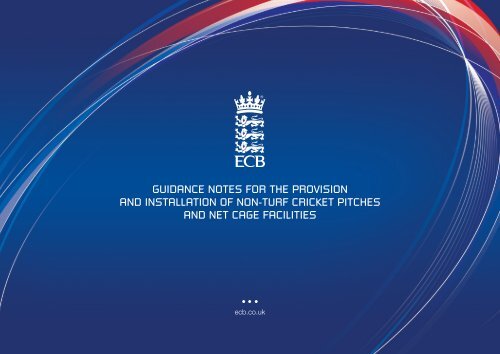
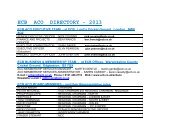
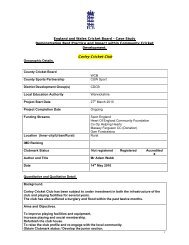


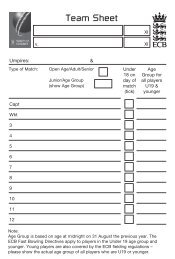
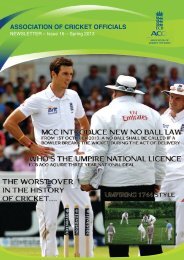
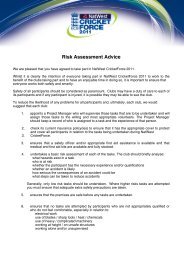
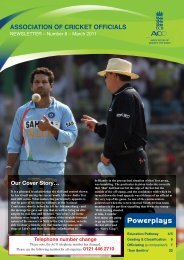


![Indoor Sports Halls with Cricket Provision [TS3] - Ecb - England and ...](https://img.yumpu.com/49070696/1/190x135/indoor-sports-halls-with-cricket-provision-ts3-ecb-england-and-.jpg?quality=85)


